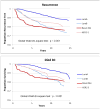Intrinsic subtypes from the PAM50 gene expression assay in a population-based breast cancer survivor cohort: prognostication of short- and long-term outcomes
- PMID: 24521998
- PMCID: PMC4105204
- DOI: 10.1158/1055-9965.EPI-13-1017
Intrinsic subtypes from the PAM50 gene expression assay in a population-based breast cancer survivor cohort: prognostication of short- and long-term outcomes
Abstract
Background: The PAM50, a gene expression assay to categorize breast tumors into intrinsic subtypes, has not been previously used to examine short- and long-term prognostication in a population-based cohort where treatment patterns and time of initial follow-up vary.
Methods: In a stratified case-cohort design of 1,691 women from the LACE and Pathways breast cancer survivor cohorts, we used PAM50 to categorize tumors into Luminal A (LumA), Luminal B (LumB), HER2-enriched (HER2-E), Basal-like and Normal-like, and to examine risk of early and late recurrence and mortality by Cox proportional hazards regression.
Results: Compared with LumA, cumulative risk of recurrence and breast cancer death was higher for LumB, HER2-E, and Basal-like tumors at 2, 5, and 10 years. However, HR of breast cancer death varied over time [<5 years (early) vs. > 5 years (late)] for both Basal-like (HR, 6.23 early vs. HR, 0.63 late) and HER2-E tumors (HR, 2.97 early vs. HR, 0.73 late) but not for LumB tumors where risk was elevated consistently (HR, 2.67 early vs. HR, 1.47 late). The contrast between LumB, HER2-E, and Basal-like compared with LumA on early recurrence was stronger when subtype was defined by PAM50 than by immunohistochemistry (IHC) markers.
Conclusions: The PAM50 categorized intrinsic subtypes in a manner that more accurately predicts recurrence and survival, especially for luminal tumors, compared with commonly used methods that rely on traditional IHC clinical markers.
Impact: The PAM50 is robust for use in epidemiologic studies and should be considered when archived tumor tissues are available.
©2014 AACR.
Conflict of interest statement
Potential conflict of interest: PSB has an interest in Bioclassifier LLC. The other authors declare that they have no competing interests.
Figures
References
-
- Ellis P. WHO Classification of Tumours. Pathology and Genetics of Tumours of Breast and Female Genital Organs Tumours. 2003
-
- Weigelt B, Reis-Filho JS. Histological and molecular types of breast cancer: is there a unifying taxonomy? Nat Rev Clin Oncol. 2009;6:718–30. - PubMed
-
- Paik S, Shak S, Tang G, Kim C, Baker J, Cronin M, et al. A multigene assay to predict recurrence of tamoxifen-treated, node-negative breast cancer. N Engl J Med. 2004;351:2817–26. - PubMed
Publication types
MeSH terms
Substances
Grants and funding
LinkOut - more resources
Full Text Sources
Other Literature Sources
Medical
Molecular Biology Databases
Research Materials
Miscellaneous



